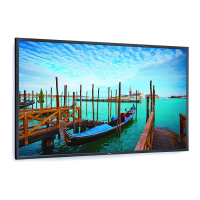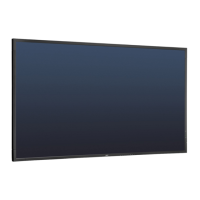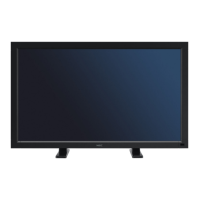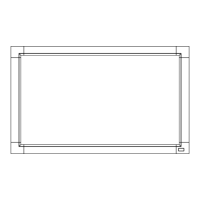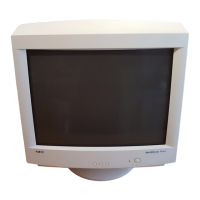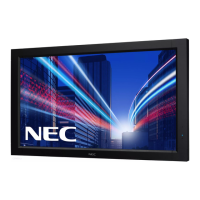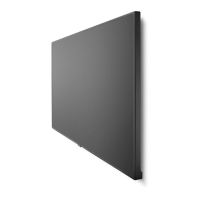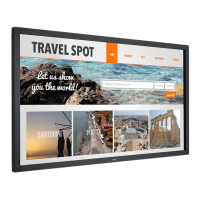
Do you have a question about the NEC MultiSync V554 and is the answer not in the manual?
| Power consumption (standby) | - W |
|---|---|
| Power consumption (typical) | 120 W |
| Portrait mode | Yes |
| Annual energy consumption | 175 kWh |
| Panel life | - h |
| Pixel pitch | - mm |
| Response time | 8 ms |
| Display diagonal | 55 \ |
| Display brightness | 500 cd/m² |
| Display technology | LED |
| Vertical scan range | 24 - 85 Hz |
| Horizontal scan range | 31.5 - 91.1 kHz |
| LED backlighting type | Edge-LED |
| Display number of colors | 1.073 billion colors |
| Display diagonal (metric) | 138.78 cm |
| Active display area (W x H) | 1209.6 x 680.4 mm |
| Internal memory | 1 GB |
| Processor cores | 4 |
| Processor model | A53 |
| Processor family | ARM Cortex |
| Processor frequency | 1.2 GHz |
| Audio formats supported | MP3, WAV |
| Image formats supported | JPG, PNG |
| Video formats supported | FLV, MOV, MP4 |
| Internal storage capacity | 16 GB |
| USB version | 2.0 |
| USB ports quantity | 5 |
| DisplayPorts quantity | 3 |
| Ethernet LAN data rates | 10, 100 Mbit/s |
| VGA (D-Sub) input ports | 1 |
| Purpose | - |
| Operating hours (hours/days) | 24/7 |
| Product color | Black |
| Product design | Digital signage flat panel |
| Bezel width (bottom) | 14.2 mm |
| Panel mounting interface | 300 x 300 mm |
| Operating temperature (T-T) | 0 - 40 °C |
| Operating relative humidity (H-H) | 20 - 80 % |
| Certification | C-tick; CE; EMC Class B; FCC; PSB; TÜV GS; UL/C-UL or CSA; VCCI |
| Sustainability certificates | RoHS, ENERGY STAR |
| RMS rated power | 20 W |
| Cables included | AC, DVI |
| Depth | 62.9 mm |
|---|---|
| Width | 1244 mm |
| Height | 714.8 mm |
| Weight | 24500 g |
Information and precautions regarding the use of specific cables to avoid interference.
Compliance information related to the Federal Communications Commission rules.
Safety warnings regarding electrical shock, fire hazards, and proper unit operation.
Precautions for safe operation, handling, and maintenance to prevent damage or injury.
Guidelines for safe operation, handling, and routine maintenance of the monitor.
Recommendations for optimal ergonomic setup and viewing comfort to enhance user experience.
Instructions for safely cleaning the LCD monitor screen using a soft cloth.
Guidelines for cleaning the monitor's exterior cabinet with appropriate solutions.
Essential precautions and recommendations for safely mounting the monitor.
Specific considerations for installing the monitor on walls or ceilings, including support.
Guidelines for selecting suitable mounting locations and ensuring ceiling structural integrity.
Routine maintenance checks and proper orientation guidelines for portrait mode operation.
Steps for attaching various mounting accessories like brackets and adapters.
Instructions for installing optional boards and using wall mount adapters.
Procedures for installing and removing the optional table top stand.
Guidelines for ensuring adequate ventilation when mounting the monitor in enclosed spaces.
Identification and description of the monitor's control panel buttons and indicators.
Connectors for video, audio signals, and speaker output.
Ports for external control, network connectivity, and USB/microSD storage.
Terminals for external speakers, optional components, and wireless data sensors.
Slots for installing optional boards like the Raspberry Pi Compute Module.
Detailed description of each button and its function on the wireless remote control.
Information on the optimal operating range and proper handling of the remote control.
Guidance on determining installation location and installing remote control batteries.
Steps for connecting external devices and the power cord to the monitor.
Notes on cable usage and the sequence of operations after connecting equipment.
Specific settings recommended to reduce image persistence and optimize performance.
Instructions for connecting computers via PC, HDMI, and DisplayPort interfaces.
How to connect USB devices for storage, power, or control.
How to turn the monitor on and off using the power button and remote control.
Explanation of LED indicator states and their corresponding meanings.
First-time setup prompts and details on the monitor's power management functions.
Options for adjusting the image aspect ratio for different display modes.
How to use the media player and a list of supported file types.
Details on background music support and audio file specifications.
Requirements and limitations for using microSD memory cards with the media player.
Guidelines for using USB storage devices with the media player.
How files are displayed and navigated within the media player interface.
How to set up and display slideshows of images and movies.
Options for configuring slideshow, auto play, and preset content.
Configuration options for network connectivity and media player network settings.
How to share folders and copy files to microSD cards over the network.
Detailed procedure for copying files to microSD cards from a computer.
Functions for managing files on the microSD card via the network interface.
How to copy content and use emergency content playback features.
Displaying information such as input source, picture size, and communication info.
Description of available preset picture modes and their intended use.
Adjusting the overall brightness and white color temperature of the screen.
Detailed settings for adjusting gamma levels and the color gamut.
Settings for color vision emulation, uniformity, and metamerism for fine-tuning.
Available preset picture modes when SpectraView Engine is set to OFF.
Overview of the OSD menu structure and how to navigate through it.
How to navigate and make selections within the OSD using the remote control.
How to navigate and make selections within the OSD using the monitor's control panel.
How to select the desired input signal source for the monitor.
Detailed adjustments for picture mode, brightness, contrast, gamma, and color.
Controls for auto setup, position, clock, phase, and resolution adjustments.
Options to adjust the image aspect ratio, including full screen and zoom modes.
Advanced image adjustments like over scan, deinterlace, noise reduction, and image flip.
Adjustments for volume, balance, surround sound, and audio input/output.
Controls for equalizer, audio input source, and line out functionality.
How to create and manage scheduled power on/off and setting changes.
Setting the monitor's date, time, and daylight saving for scheduling.
Settings for multi-picture modes, active picture selection, and input switching.
How the monitor detects input signals and prioritizes sources.
Configuration options for various input terminals like DVI, VGA, DisplayPort, and HDMI.
Settings for OSD language, timing, position, transparency, and rotation.
Options for configuring multi-monitor setups like Tile Matrix and setting copy.
Settings for arranging a single image across multiple screens using Tile Matrix.
Assigning and managing monitor IDs and IP addresses for network control.
Settings for power saving, fan control, screen saver, and image persistence reduction.
Network configuration, IP settings, and general monitor control options.
Options for password protection, button locking, and remote control security.
Settings for DDC/CI, PING, and IP address configuration/reset.
Automatic adjustment of backlight and brightness based on ambient light and human presence.
Control of power indicator, schedule indicator, and network function enable/disable.
Settings related to USB power supply, external control, and PC source selection.
How to enable and configure HDMI CEC features for device control.
Configuration options for optional boards, including power, audio, and PC control.
Settings for the display channel when using Slot 2 options.
How to connect multiple monitors using RS-232C, REMOTE IN, or LAN daisy-chaining.
How to use the remote control to manage multiple monitors via unique IDs.
Technical details of the RS-232C interface, including protocol and pin configurations.
Detailed pin assignment for the RS-232C input/output connector.
How to connect and control the monitor using a PC via RS-232C cable.
Technical details of the RS-232C interface, including protocol and baud rate.
Detailed pin assignment for the RS-232C connector.
How to connect the monitor to a network for control via HTTP browser.
Steps for setting up network parameters using a web browser.
Information on accessing monitor settings via IP address or hostname.
How to control the monitor and access OSD menus using a web browser.
How to set up IP address, subnet mask, default gateway, and DNS servers.
How to configure email alerts for monitor errors and status messages.
A list of error codes, their explanations, and recommended measures.
How to use SNMP for network status monitoring and control.
Settings for AMX device discovery and Crestron RoomView integration.
Defining monitor names and hostnames for network identification.
Configuring PJLink, notification, and HTTP password settings.
Viewing monitor lists and setting custom titles and messages.
Ways to connect external devices via RS-232C or LAN.
Technical details for RS-232C and LAN interfaces, including protocol and speed.
Command codes for controlling the monitor via RS-232C and ASCII protocols.
How HDMI CEC commands control connected devices and the monitor.
How to use the point zoom feature to enlarge specific screen areas.
How the monitor reports its status and errors through the Proof of Play function.
Function for monitoring monitor status via wireless communication.
Tables showing compatibility for Picture-in-Picture mode across different inputs.
Compatibility tables for Picture-in-Picture mode with various input combinations.
How to configure video output signals, particularly from DisplayPort.
Overview of advanced features like SpectraView Engine, Natural Color Matrix, and Plug and Play.
Solutions for common display problems like no image, snowy picture, or blinking.
Addressing issues with image blinking, instability, unfocused, or swimming appearance.
Solutions for issues with selected resolution, no sound, and remote control functionality.
Troubleshooting problems with scheduling, USB hubs, and network controls.
Detailed technical specifications for the P404 model, including dimensions and performance.
Detailed technical specifications for the V404 model, including dimensions and performance.
Detailed technical specifications for the P484 model, including dimensions and performance.
Detailed technical specifications for the V484 model, including dimensions and performance.
Detailed technical specifications for the P554 model, including dimensions and performance.
Detailed technical specifications for the V554 model, including dimensions and performance.
Guidelines for environmentally responsible disposal of old NEC products.
Information about the monitor's energy-saving capabilities and modes.
